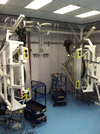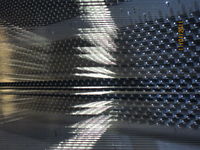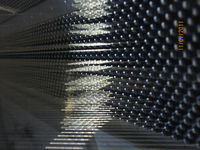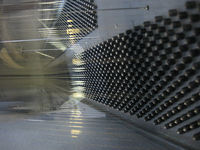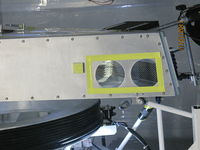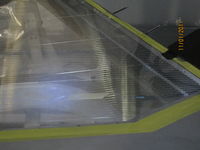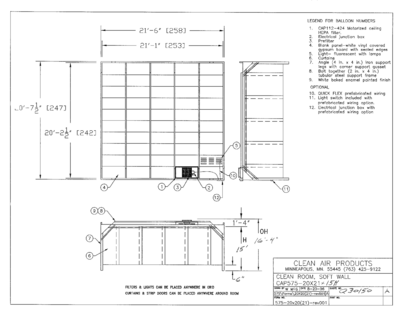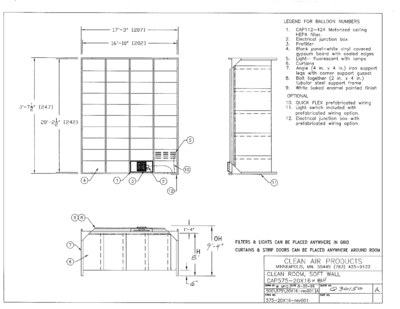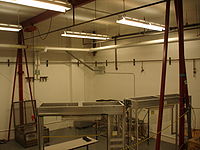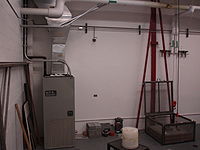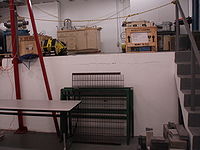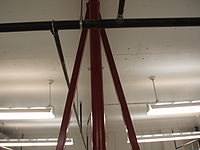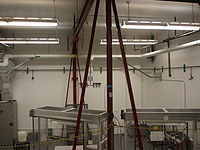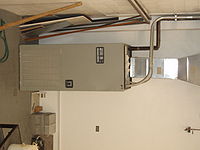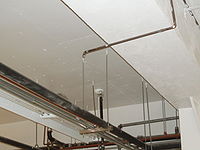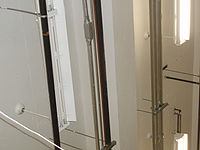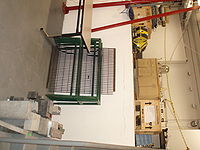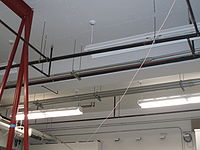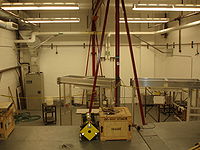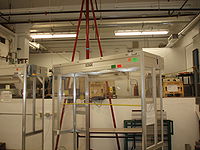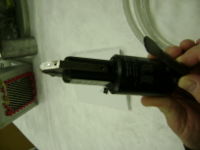Old CLAS12
The Field wires look like Idaho icicles when you turn off the lights to the clean room and shine a light through the entrance window
4 ingredients to contract
1.) MOU: Memorandum of Understanding,
2.) SOW: Statement of Work
3.) Detailed Schedule
4.) Sole Source Justification
5.) Contact person: Pre Award Dave Harris? Approve Terms and conditions
University gets a Purchase Req: covers SOW, Terms & Condition, & Schedule.
We respond with proposal containing exceptions and work plan. 1 team of 2 stringers can do a wire in 6 minutes. Stringers spend 1/2 of their time stringing the rest of time preparing , Q&A, ... JLab expects a crew of 5 people. If we think we can't make the schedule we need to ask for more people. Stringers hourly rate ($30-$35/hr with overhead and benefits). Lead stringer is +$5/hr more.
Then they respond with contract.
"Cost Reimbursable" contract, University not liable if we go over budget
Can we survey to 50 microns? No. 200 microns.
ISU Clean Room Facility
- The chamber's longest wire should be lifted 4 ft off the floor.
- Need a hand rail system so people don't fall off the ledge because they mistake the clean room wall for a solid structure.
File:BasementRenovationDrawing 6-16-10.pdf
File:BasementRenovationDrawing 6-28-10.pdf Changes to machine shop door
File:BasementRenovationDrawing 7-26-10.pdf Maybe the Final design with 8' hallways and 8' doors to the clean room
Media:Series575_CleanRoom_InstallManual.pdf
Ed cash : 242-8192 (manages electricians, call to be sure work order is in place for )
CLAS 10,000
Definition
| Class | maximum particles/m³ | FED STD 209E equivalent | |||||
|---|---|---|---|---|---|---|---|
| ≥0.1 µm | ≥0.2 µm | ≥0.3 µm | ≥0.5 µm | ≥1 µm | ≥5 µm | ||
| ISO 7 | 352,000 | 83,200 | 2,930 | Class 10,000 | |||
| ISO 9 | 35,200,000 | 8,320,000 | 293,000 | Room air | |||
HVAC performance June 2011
The HVAC system has been repaired. It was set to a temperature of 66 +/- 2 degree F. I saw the cooling light turn on at least once. On June 21,2011 the set point was changed from 66 to 72.
Below is a snapshot after I turned the set point from 66 to 72. It looks like the cycle time was about 20 minutes when set to 66 degrees and 2 degree stability.
The temperatures measured after changing the temperature set point to 72.
Temperature Oscillations observed before adding a tarp over the large doorway
Some IAC personnel moved the tarp for a little while at time index 18:40. Fortunately there will be 2 doors put in. One where the tarp is now and another 5 feet towards the basement exit. Otherwise, I would worry about the impact of opening the large door on stringing.
The temperature seems to be more stable now with the tarp over the doorway, allowing the HVAC to control the temperature in only the clean room area. Below is a graph of the temperature in the room over a 6 hour period starting at 8 am until 2 pm on June 24, 2011.
Below is a plot of the temperatures recorded over the last 7 days (4/18 - 24 / 11) when all the changes were happening to try and bring the temperature up to 72 degrees.
Below is a plot of the temperatures recorded over the last 7 days (4/21 - 27 / 11) . There appears to be a slow rise?
- 6/28/11
I went down to the clean room and and saw that the Duct work was started. There are open holes into the adjacent room right now which need to be closed up.
- I also saw that the set point has been raise to 73 degrees. This explains the temperature rise above.
- 8/11/11
Began moving the temperature sensors to new locations in the clean room. We plan on mounting them at locations which will measure the stringing temperature at the top and bottom of a chamber while we are stringing the chamber
- 8/24/11
Installed an air deflector on the 5th vent furthest from the HVAC unit at approximately 11:30 AM, fourth vent furthest at ~3:00 PM, and 3rd vent at 3:15 PM.
July 2011 HVAC performance
6/6/11
Construction begins in the clean room. I opened the tarp over our big door a little bit and now I see temperature oscillations again.
6/7/11
The first few days of July were stable but there was a positive temperature gradient slowly increasing the temperature about +1/3 degree F per day. Then on July 4 something caused temperatures to fluctuate at least 1 degree within a day. Could it be that the university turned off the AC over the weekend and there was a delay seeing the building aclimate?
Construction Quotes
We are currently waiting on quotes from the following companies on the construction of the Clean Room (both specs) at ISU. They are Modular Clean Rooms and Clean Air Products. Once quotes are received, pdf's of the quotes will be uploaded online.
2010 July 14
Quote from Clean Air Products for the ISU Basement:
Latest quote
File:Clean Air Quote 4-27-11.pdf
File:Clean Air Quote 10-15-10.pdfFile:Clean Air FilterQuote 10-15-10.pdf
File:Clean Air FilterDescript 10-15-10.pdf
File:Clean Air Quote No Filters.pdf
Dimensions of door from loading dock to clean room 65" wide 90" high
The doors into and out of the different areas will be 9'8" high in order to help facilitate the transport of equipment into and out of the different areas of the clean room.
The desks in the clean room will act as a table top area to place tools and other equipment currently in use during the construction of the wire chambers. Also, they will serve as a place to perform any calculations or other miscellaneous work that may come up while construction is ongoing.
The cabinets on the other side of the room will be a permanent storage area for all tools and equipment not currently in use at the two work stations.
The path in between the workstations and the cabinets will be kept clear of all obstructions in order facilitate the movement of equipment into and out of the room as needed.
The two workstations will be where the wire chambers are constructed. The workstations will have a standing/sitting apparatus built around them in order to help those who are stringing the wire chambers to have better access to the chambers from above. Schematics for these will be uploaded as they are designed.
The heavy equipment storage area will be where all the heavier equipment (i.e. dollies, fabrication materials, etc...) that will not fit, or does not need to be stored in the individual work station cabinets will be kept.
The HEPA filters will cover roughly ~10-12% of the ceiling in order to maintain a Class 10,000 environment. The filters will move approximately 35-40 air volumes per hour.
Overhead lighting will be suspended from the frame in order to provide sufficient lighting for the room occupants to work within.
Floor paint
File:ArmoSeal1000epoxypaint.pdf
Pictures of Path from Dock to clean room
As measured on the spit in the JLab clean room on April 28, 2011. The narrowest part of the R1 detector was 78". A door should accomodate 78" + box.
The Tip of the stringing fixture was 13' 5" high from the floor.
Below are pictures showing how our R1 mock up, an equilateral triangle 8' on the side, passes from the loading dock to the clean room area.
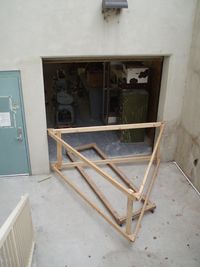 |
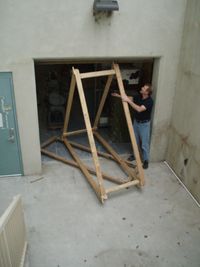
|
| The 8' wide mock up is a few inches larger than the loading dock door. | The mock up is just able to pass through the door when standing up. |
The R1 chambers will pass through 2 newly cut doorways to the clean room
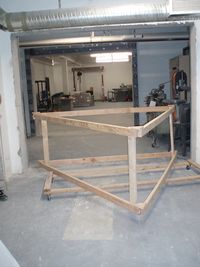 |
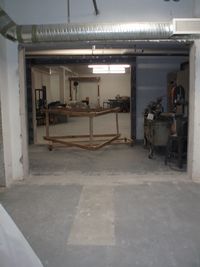
|
| The 8' wide mock has several inches to spare going through the first doorway. | The second doorway is the same width as the first. |
- Photos courtesy of Dr. Philip Cole
Pictures of the ISU Squash Court
6/18/09
The clean room needs space for instrumenting. The DC will be layed horizontal so PC cards can be mounted and tested.
ODU's Clean Room
ODU's current clean room size:
20 ' high 20 ' Width 40 ' Length
CLAS 10,00 clean rooms
Discussion items
1.) Budget
- JLab to ISU travel for JLab personnel to inspect operations
- shipping container for R1 chambers
2.) Clean room
cost =
assume we copy the ODU clean room
Using IAC conference room space, need to remove carpet and paint floor.
3.) hiring timeline
9/08 NSF proposal submission
4.) stringing platform and DC stringing support arm
5.) Manpower
6.) MOU to support post doc request or faculty release time
7.) Stringing equipment
a.) crimping tool
b.) glue
c.) wire or feedthroughs?
d.) wire tension measurement (PC, Magnets, associated electronics
A few pictures ff the R1 full size proto type from my JLab visit on 9/16/07. It is about 6 feet tall. CLAS12_R1_Prototype_9-16-07
The air actuated crimping tool:
JLab job posting for lead stringer
add should be available at
https://isujobs.net/applicants/jsp/shared/Welcome_css.jsp
CLAS Wire Chamber Technician
Requisition Number 10534 Job Category Technician/Drafter Percentage of Travel No Travel Job Responsibilities (TERM POSITION ENDING TWO YEARS FROM HIRE DATE)
DATE POSTED: FEBRUARY 11, 2010
SALARY RANGE: $45,500 - $61,900 (TD II)
DUTIES: Technician will be responsible for the fabrication of very large and very precise particle detection units called "wire chambers" in support of the CLAS 12 GEV project. These "wire chambers" will be built in a clean room by teams. Incumbent is expected to lead these fabrication teams. Specifically, individual will be responsible for leading a team in building these detectors and maintaining strict quality controls. Will be required to learn all aspects of detector fabrication, stringing and testing. Will fabricate and string the detectors maintaining high precision and quality. Will receive, clean and inspect parts for compliance with technical specifications.
Experience/Education Required MINIMUM QUALIFICATIONS:
Associates Degree plus 3 years of applicable experience or equivalent combination of education and relevant experience. Knowledge of basic electricity and/or electronics required. Knowledge and experience in the proper use of hand and power tools as well as ability to follow written procedures in operating and technical manuals also required. Basic computer skills such as Excel and/or CAD experience is a plus. Ability to work in a team environment. A background in quality control as well as experience supervising and motivating others in a team setting preferred.
Physical Requirements: - Pass all medical requirements for the following qualifications: Rad Worker, ODH, Crane Operator, Forklift Operator, Aerial Platform Operator, etc. - Cannot have a fear of heights or confined spaces. - Must be able to climb stairs, ladders, vertical escape ladders and work in close quarters with others. - Steady hands and eyes for delicate close-up work.
During interview have them try to crimp a wire.
Master rigger, to manipulate the chamber onto the stringing platform.
Master rigger class at JLab on November 2-4, 2010. Overhead training class pre-req. contact kelley
Overhead crane class,
